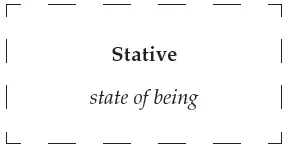Chapter 6
Verbal Lexeme Basics
In order to examine the function of verbal aspect within New Testament text, we must first know something about verbal lexemes. The reason for this is that verbal aspect operates in cooperation with various lexemes to produce Aktionsart expression.
There are many different ways to analyze verbal lexemes. We will restrict our interest to the most important categorizations, which are directly relevant to our analysis of verbal pragmatics. Furthermore, our analysis would be strengthened by considering the range of usage of each lexeme by consulting a lexicon such as BDAG. We will at this stage, however, restrict our analysis to consideration of the gloss definition of each lexeme. With most lexemes, categorization is straightforward and unambiguous. There are, however, some lexemes for which categorization is a little ambiguous, but this should not give cause for concern.
The first decision we need to make when looking at a verbal lexeme is whether or not the lexeme is transitive or intransitive.
Transitive Lexemes
A lexeme is transitive if the action is performed upon an object. The action is performed by a subject and done to someone or something (the object). Whether or not a lexeme is transitive is decided simply by what the type of action is. In English, lexemes such as hit, give, kick, throw, arrange, and so on are all transitive. A person may hit a target, give a gift, kick a ball, throw a javelin, or arrange a meeting. We must note that, according to the definitions offered here, not all lexemes that take an object are necessarily transitive. The object must be affected or impacted somehow. So, for example, to hear music is not regarded here as transitive because the music is not affected by the action, even though it is the object of the action. To reiterate, for a lexeme to be transitive, there must be some kind of “exchange” from the subject to the object.1
Key question:
Is the action performed upon an object?
If yes = transitive lexeme
| 1. Transitive | 2. Intransitive |
| performed upon an object | not performed upon an object |
Intransitive Lexemes
If a lexeme is not transitive, it must be intransitive. An intransitive lexeme is one that does not require an object or does not perform an action upon its object. The action is performed by a subject, but it is not done to anyone or anything (though it may be done with reference to someone or something). In other words, an intransitive lexeme may take an object, but this must be unaffected by the action performed by the subject. For example, in the phrase to hear music, the hearer does not act on the music, even though it is the object of the verb. Whether or not a lexeme is intransitive is decided simply by what the type of action is. In English, lexemes such as sleep, know, live, die, and so on are all intransitive.
Key question:
Is the action performed upon an object?
If no = intransitive lexeme
Ambitransitive Lexemes
It is worth noting that some lexemes are difficult to categorize as either transitive or intransitive. The fact is that in most languages, there are certain lexemes that can be either transitive or intransitive, depending on the context. They may act upon an object in some situations (and so are transitive), or they may not act upon an object in other situations (and so are intransitive). These lexemes are best labelled “ambitransitive,” because they can go either way. In English, lexemes such as eat, read, breathe, and so on are all ambitransitive. For example, it’s time to eat is intransitive, but I ate my lunch is transitive. He’s breathing is intransitive, but we need to breath oxygen is transitive.
Subcategories
Though it is possible to subcategorise transitive and intransitive verbs into several other types of lexemes, we will explore only two subcategories: punctiliar lexemes and stative lexemes.
Transitive: Punctiliar
If a lexeme is transitive, it may also be punctiliar. A punctiliar action is performed upon an object and is instantaneous in nature. It is a once-occurring, immediate type of action. Whether or not a lexeme is punctiliar is decided simply by what the type of action is. While a punctiliar action can be repeated, it cannot be drawn out for any length of time. In English, lexemes such as punch, kick, throw, and the like are all punctiliar. A person may punch a bag for two minutes, but this must be a series of punches; one punch cannot last for two minutes.
Key questions:
Is the action performed upon an object?
If yes = transitive
Is the action instantaneous?
If yes = punctiliar
If a transitive lexeme is not punctiliar, we will simply call it transitive without specifying further. Examples of lexemes that are transitive but not punctiliar are give, arrange, defeat, and so on.
Intransitive: Stative
If a lexeme is intransitive, it may also be stative. A stative verb is not performed upon an object and describes a state of being. It is not time bound or progressive; it simply is. In fact, we may even consider a stative lexeme as a verb that is not really an action—it is simply a state. Whether or not a lexeme is stative is decided simply by what the type of action is. In English, lexemes such as know, trust, live, and so on are all stative.
Key questions:
Is the action performed upon an object?
If no = intransitive
Does the action describe a state of being?
If yes = stative
If an intransitive lexeme is not stative, we will simply call it intransitive without specifying further. Examples of lexemes that are intransitive but not stative are sleep, die, decide, and the like.
| Transitive | Intransitive |
performed upon an object
| not performed upon an object
|
Some Greek Lexemes
Here are some comm...





